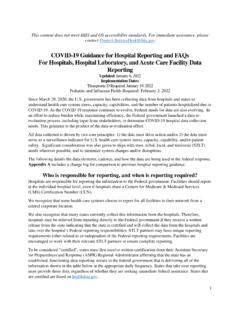Transcription of 2021 Guide to Telework and Remote Work in the Federal ...
1 April 2011 Guide to Telework in the Federal Government1 Table of Contents INTRODUCTION AND BACKGROUND .. 2 Introduction .. 2 Legislative Background .. 2 What is Telework ? .. 4 Definition .. 4 Types of Telework Arrangements .. 4 Telework GUIDANCE BY AUDIENCE .. 6 Federal Agencies/ Telework Managing Officers .. 6 Telework Fundamentals .. 6 Agency Roles and Responsibilities .. 7 Telework Policies .. 9 Eligibility and 14 Training .. 16 Telework Agreements .. 17 Telework Managing Officer (TMO) .. 18 Reporting .. 20 Managers and Supervisors .. 21 How do Federal Managers and Supervisors Benefit from Telework ? .. 21 How to Be an Effective Manager or Supervisor of Teleworkers .. 21 Employees .. 26 Why Would I Want to Participate in Telework ? .. 26 How to Be an Effective Teleworker .. 26 ADDITIONAL GUIDANCE .. 30 Safety .. 30 Performance Management .. 30 Pay, Leave and Work Schedule Flexibilities.
2 30 Pay .. 30 Pay During Temporary Telework Arrangements .. 31 Premium Pay .. 32 Leave and Work Scheduling Flexibilities .. 32 Telework and Continuity of Operations .. 33 Manager Responsibilities .. 34 Teleworker Responsibilities .. 34 Washington, DC, Area Dismissal and Closure Procedures (Unscheduled Telework Option) .. 35 Recruitment and Retention .. 35 Accommodations for Employees with Disabilities .. 36 Conclusion .. 37 REFERENCES .. 38 2 INTRODUCTION AND BACKGROUND Introduction The Federal Government is a leader in the use of innovative workplace flexibilities, including Telework . In March 2010, President Obama hosted a White House Forum on flexibilities, emphasizing their vital role in recruiting and retaining the best and brightest workers and maximizing their effectiveness. Congress passed the Telework Enhancement Act of 2010 to catalyze expansion. Federal Telework programs are established primarily to meet agency mission and operational needs.
3 Telework saves money by helping government reduce real estate and energy costs and promote management efficiencies; makes us more resilient in severe weather and other emergencies; improves the quality of employee work-life; and increases employment opportunities for persons with disabilities. Advances in information technology have paved the way for increased Telework . However, Telework is not a new concept and is not necessarily dependent on the use of technology. The key is for managers and employees to clearly define the work expectations and objectives, and then to give employees the tools and flexibility needed to get the job done. This Guide to Telework in the Federal Government outlines practical information to assist Federal agencies, managers, supervisors, Telework Managing Officers1 Legislative Background , other staff responsible for implementing Telework , and employees.
4 Perhaps you are an employee who would like to know more about Telework . Maybe you manage or supervise teleworking staff and hope to develop a better understanding of the day-to-day aspects of this important flexibility. You may be a Telework Managing Officer or another staff member tasked with oversight or operational responsibilities related to the Telework program at your agency. Perhaps you are a labor representative with a need to know the finer points of a great Telework program. If any of these describe your situation, then this Guide is for you. For many years, laws addressing t elework (under various names work at home, flexible work, telecommuting, etc.) have been in effect for Federal employees. The initial legislative mandate for Telework was established in 2000 ( 359 of Public Law 106-346). This law states that [e]ach executive agency shall establish a policy under which eligible employees of the agency may participate in telecommuting to the maximum extent possible without diminished employee performance.
5 Associated language in the conference report for this legislation expanded on that requirement where it said that [e]ach agency participating in the program shall develop criteria to be used in implementing such a policy and ensure that managerial, logistical, organizational, or other barriers to full implementation and successful functioning of the policy are removed. Each ag ency should also provide for adequate administrative, human resources, technical, and logistical support for carrying out the policy. 1 A senior-level official at each agency responsible and accountable for policy development and implementation related to the agency s Telework program. 3 Further legislation (Public Law 108-199, Division B, 627 of January 23, 2004, and Public Law 108-447, Division B, 622 of December 8, 2004) followed this mandate with directives to certain agencies to increase Telework participation in the workforce by specified amounts.
6 In response to the original congressional mandate, the Office of Personnel Management (OPM) began to survey Federal agencies about Telework in 2000. By means of the annual Call for Telework Data, OPM collaborates with Federal agencies to collect information about individual agency Telework programs, including participation rates. The analysis of that data is presented in the yearly Status of Telework in the Federal Government Report to the Congress, published annually since 2002. You may review these reports for historical and background information on Federal Telework at the central website at The Telework Enhancement Act of 2010 (the Act), was signed into law on December 9, 2010. The passage and signing of this legislation (Public Law 111-292) was a significant milestone in the history of Federal Telework . The Act is a key factor in the Federal Government s ability to achieve greater flexibility in managing its workforce through the use of Telework .
7 The law specifies roles, responsibilities and expectations for all Federal executive agencies with regard to Telework policies; employee eligibility and participation; program implementation; and reporting. It also assigns specific duties to OPM; General Services Administration (GSA); Office of Management and Budget (OMB); Department of Homeland Security (DHS), including the Federal Emergency Management Agency (FEMA); National Archives and Records Administration (NARA); and others. The specific agencies named in the Act are charged with directing overall policy and providing policy guidance to Federal executive agencies on an ongoing basis. The Act established baseline expectations for the Federal Telework program and agencies have been diligent to implement its requirements seamlessly and effectively. 4 What is Telework ? Definition The official definition of Telework can be found in the Telework Enhancement Act of 2010 (the Act): "[t]he term ' Telework ' or 'teleworking' refers to a work flexibility arrangement under which an employee performs the duties and responsibilities of such employee's position, and other authorized activities, from an approved worksite other than the location from which the employee would otherwise work.
8 " In practice, " Telework " is a work arrangement that allows an employee to perform work, during any part of regular, paid hours, at an approved alternative worksite ( , home, Telework center). This definition of Telework includes what is generally referred to as Remote work but does not include any part of work done while on official travel or mobile work. Remote : In the past, agencies have sometimes used this term to describe a work arrangement in which the employee resides and works at a location beyond the local commuting area of the employing organization's worksite or to describe a full-time Telework arrangement. For reporting purposes, these employees should be included as teleworkers. MOBILE: Work which is characterized by routine and regular travel to conduct work in customer or other worksites as opposed to a single authorized alternative worksite. Examples of mobile work include site audits, site inspections, investigations, property management, and work performed while commuting, traveling between worksites, or on Temporary Duty (TDY).
9 You may also be familiar with the terms telecommuting and flexible workplace and both are sometimes used to describe what we now generally refer to as Telework . While Remote and mobile work are also terms that are sometimes used as synonyms for Telework , they tend to operate differently than Telework as is apparent in the detailed operational definition. For consistency, OPM recommends that all agencies use the term Telework for reporting purposes and for all other activities related to policy and legislation, as defined in the Act. Types of Telework Arrangements Generally speaking, there are two types of Telework ; 1) routine Telework in which Telework occurs as part of an ongoing, regular schedule and 2) situational Telework that is approved on a case-by-case basis, where the hours worked were NOT part of a previously approved, ongoing and regular Telework schedule. Examples of situational Telework include Telework as a result of inclement weather, doctor appointment, or special work assignments, and is sometimes also referred to as situational, episodic, intermittent, unscheduled, or ad-hoc Telework .
10 It is important to note that any employee who wishes to Telework (regardless of which type) must first successfully complete an interactive Telework training program provided by the agency and must enter into a written agreement with his/her supervisor. OPM recommends that supervisors and managers of teleworking employees complete Telework training. 5 When one typically refers to a "teleworker," the picture that most often comes to mind is the first type described above, , someone who is approved to Telework on a schedule that is regular and recurring, most often on an agreed-upon day or days during a bi-weekly pay period ( , someone teleworks "every Wednesday" or "every Tuesday and Thursday"). The specific days that are regularly scheduled for Telework are spelled out in a written Telework agreement between the employee and that employee's supervisor. There are many different scenarios in which an employee can be approved for Telework under the second type described above, , situational, episodic, or ad-hoc.


